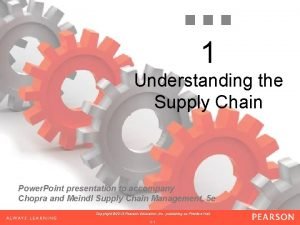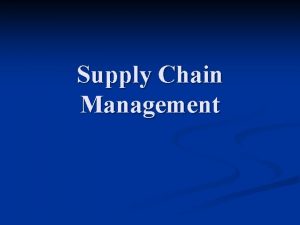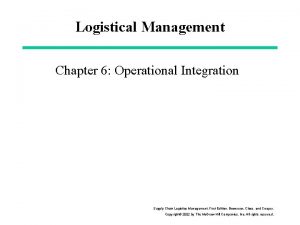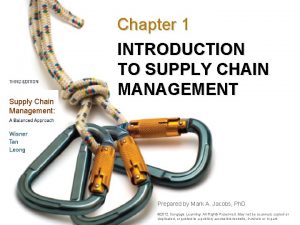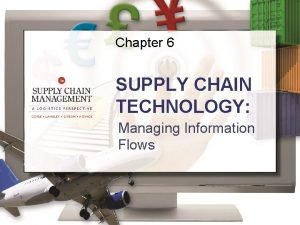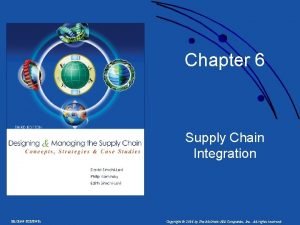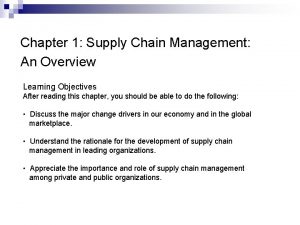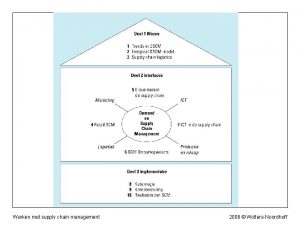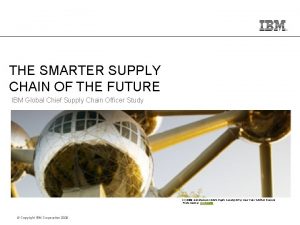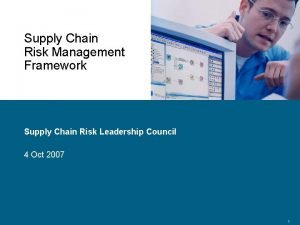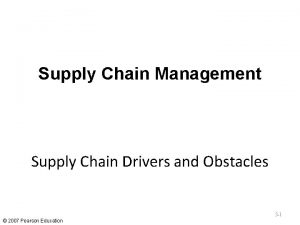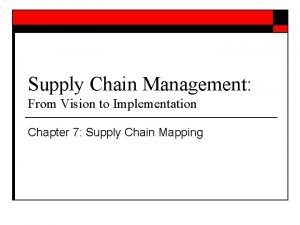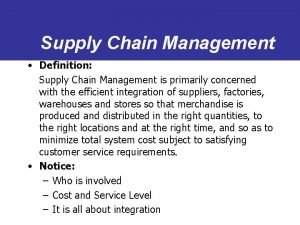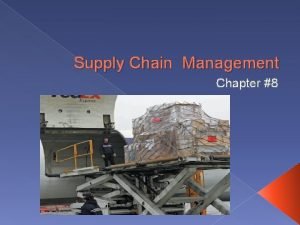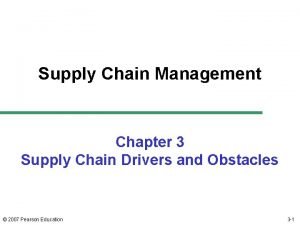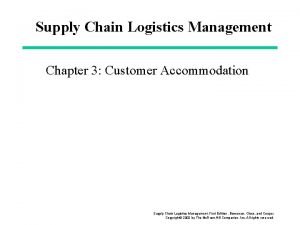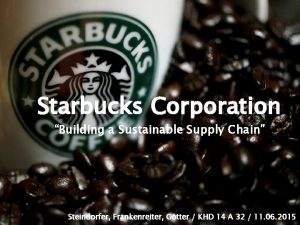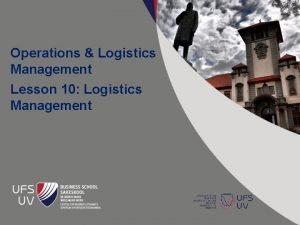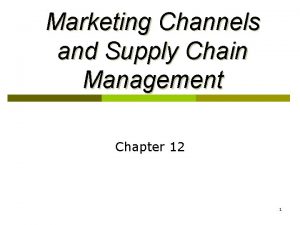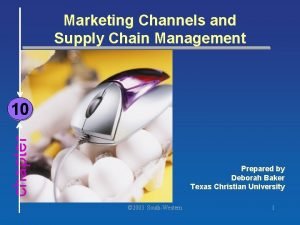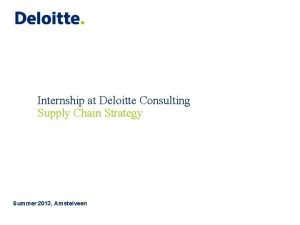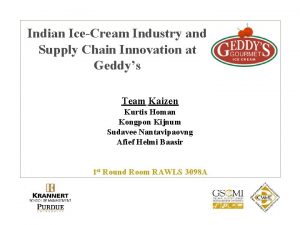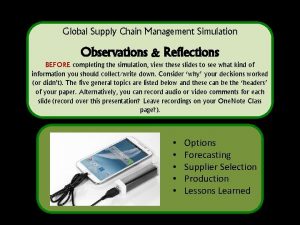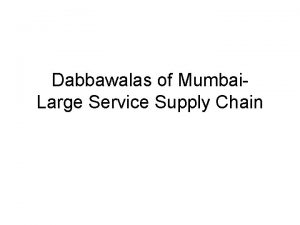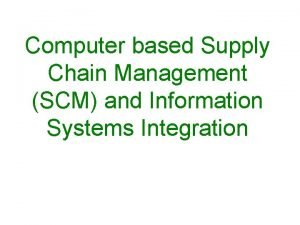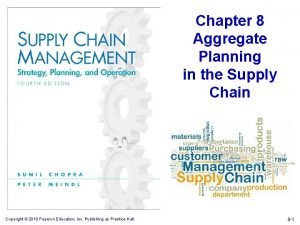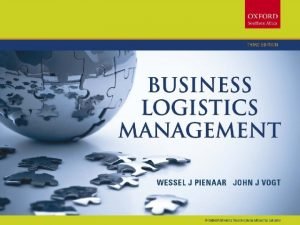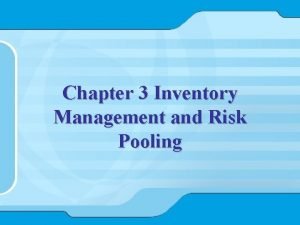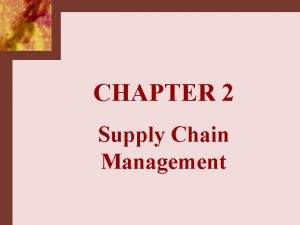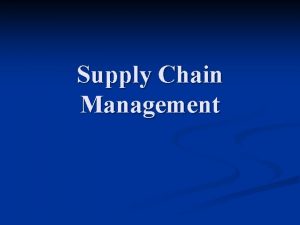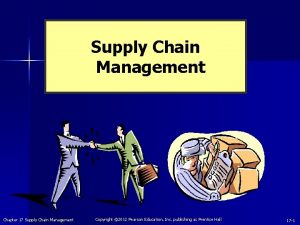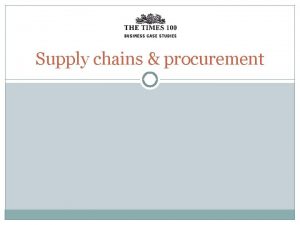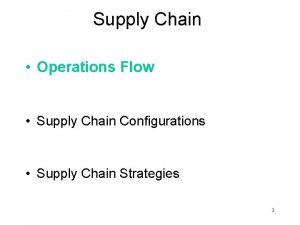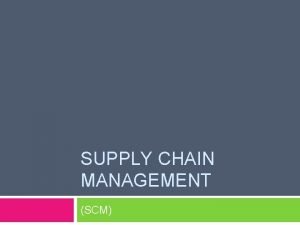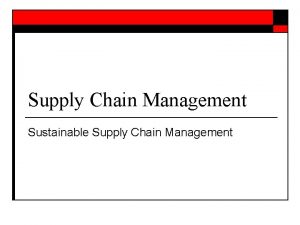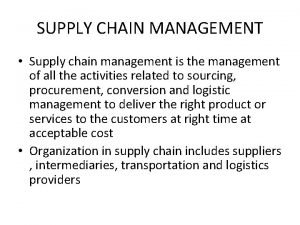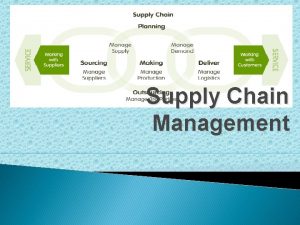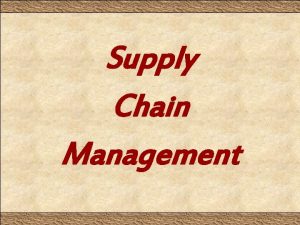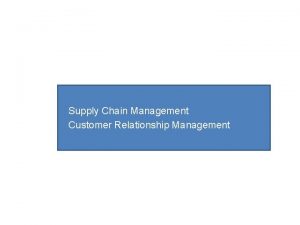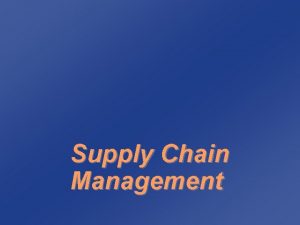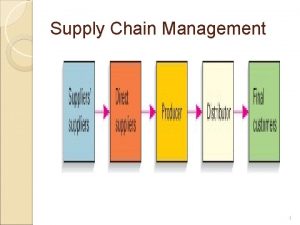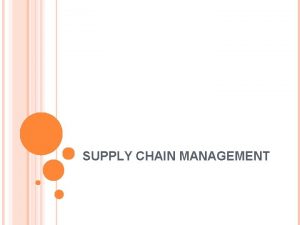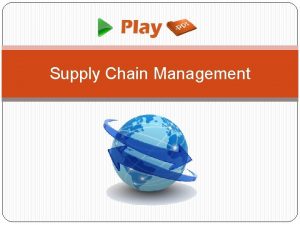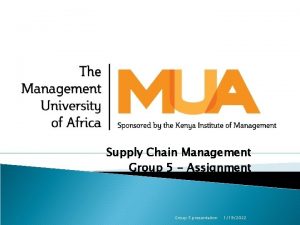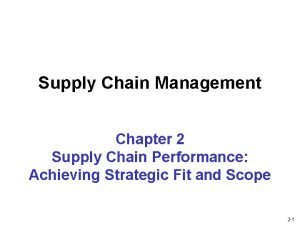Supply Chain Management 2 nd Edition Chapter 1





































- Slides: 37

Supply Chain Management (2 nd Edition) Chapter 1 Understanding the Supply Chain © 2004 Prentice-Hall, Inc. 1 -1

Traditional View: Logistics in the Economy (1990, 1996) u u Freight Transportation Inventory Expense Administrative Expense Logistics Related Activity $352, $455 Billion $221, $311 Billion $27, $31 Billion 11%, 10. 5% of GNP Source: Cass Logistics © 2004 Prentice-Hall, Inc. 2

Traditional View: Logistics in the Manufacturing Firm u Profit 4% Profit Logistics Cost u Logistics Cost 21% u Marketing Cost 27% u Manufacturing Cost © 2004 Prentice-Hall, Inc. 48% Marketing Cost Manufacturing Cost 3

Supply Chain Management: The Magnitude in the Traditional View u Estimated that the grocery industry could save $30 billion (10% of operating cost) by using effective logistics and supply chain strategies – A typical box of cereal spends 104 days from factory to sale – A typical car spends 15 days from factory to dealership u Laura Ashley turns its inventory 10 times a year, five times faster than 3 years ago © 2004 Prentice-Hall, Inc. 4

Supply Chain Management: The True Magnitude u u u Compaq estimates it lost $. 5 billion to $1 billion in sales in 1995 because laptops were not available when and where needed When the 1 gig processor was introduced by AMD, the price of the 800 mb processor dropped by 30% P&G estimates it saved retail customers $65 million by collaboration resulting in a better match of supply and demand © 2004 Prentice-Hall, Inc. 5

Outline u u u What is a Supply Chain? Decision Phases in a Supply Chain Process View of a Supply Chain The Importance of Supply Chain Flows Examples of Supply Chains © 2004 Prentice-Hall, Inc. 6

What is a Supply Chain? u u Introduction The objective of a supply chain © 2004 Prentice-Hall, Inc. 7

What is a Supply Chain? u u All stages involved, directly or indirectly, in fulfilling a customer request Includes manufacturers, suppliers, transporters, warehouses, retailers, customers Within each company, the supply chain includes all functions involved in fulfilling a customer request (product development, marketing, operations, distribution, finance, customer service) Examples: Fig. 1. 1 (Wal-Mart), Dell © 2004 Prentice-Hall, Inc. 8

What is a Supply Chain? u u u Customer is an integral part of the supply chain Includes movement of products from suppliers to manufacturers to distributors, but also includes movement of information, funds, and products in both directions Probably more accurate to use the term “supply network” or “supply web” Typical supply chain stages: customers, retailers, distributors, manufacturers, suppliers (Fig. 1. 2) All stages may not be present in all supply chains (e. g. , no retailer or distributor for Dell) © 2004 Prentice-Hall, Inc. 9

What is a Supply Chain? P&G or other manufacturer Plastic Producer Chemical manufacturer (e. g. Oil Company) © 2004 Prentice-Hall, Inc. Jewel or third party DC Tenneco Packaging Paper Manufacturer Jewel Supermarket Customer wants detergent and goes to Jewel Chemical manufacturer (e. g. Oil Company) Timber Industry 10

Flows in a Supply Chain Information Product Customer Funds © 2004 Prentice-Hall, Inc. 11

The Objective of a Supply Chain u u u Maximize overall value created Supply chain value: difference between what the final product is worth to the customer and the effort the supply chain expends in filling the customer’s request Value is correlated to supply chain profitability (difference between revenue generated from the customer and the overall cost across the supply chain) © 2004 Prentice-Hall, Inc. 12

The Objective of a Supply Chain u u u Example: Dell receives $2000 from a customer for a computer (revenue) Supply chain incurs costs (information, storage, transportation, components, assembly, etc. ) Difference between $2000 and the sum of all of these costs is the supply chain profit Supply chain profitability is total profit to be shared across all stages of the supply chain Supply chain success should be measured by total supply chain profitability, not profits at an individual stage © 2004 Prentice-Hall, Inc. 13

The Objective of a Supply Chain u u u Sources of supply chain revenue: the customer Sources of supply chain cost: flows of information, products, or funds between stages of the supply chain Supply chain management is the management of flows between and among supply chain stages to maximize total supply chain profitability © 2004 Prentice-Hall, Inc. 14

Decision Phases of a Supply Chain u u u Supply chain strategy or design Supply chain planning Supply chain operation © 2004 Prentice-Hall, Inc. 15

Supply Chain Strategy or Design u u Decisions about the structure of the supply chain and what processes each stage will perform Strategic supply chain decisions – – u u Locations and capacities of facilities Products to be made or stored at various locations Modes of transportation Information systems Supply chain design must support strategic objectives Supply chain design decisions are long-term and expensive to reverse – must take into account market uncertainty © 2004 Prentice-Hall, Inc. 16

Supply Chain Planning u u u Definition of a set of policies that govern short-term operations Fixed by the supply configuration from previous phase Starts with a forecast of demand in the coming year © 2004 Prentice-Hall, Inc. 17

Supply Chain Planning u Planning decisions: – – – u Which markets will be supplied from which locations Planned buildup of inventories Subcontracting, backup locations Inventory policies Timing and size of market promotions Must consider in planning decisions demand uncertainty, exchange rates, competition over the time horizon © 2004 Prentice-Hall, Inc. 18

Supply Chain Operation u u u Time horizon is weekly or daily Decisions regarding individual customer orders Supply chain configuration is fixed and operating policies are determined Goal is to implement the operating policies as effectively as possible Allocate orders to inventory or production, set order due dates, generate pick lists at a warehouse, allocate an order to a particular shipment, set delivery schedules, place replenishment orders Much less uncertainty (short time horizon) © 2004 Prentice-Hall, Inc. 19

Process View of a Supply Chain u u Cycle view: processes in a supply chain are divided into a series of cycles, each performed at the interfaces between two successive supply chain stages Push/pull view: processes in a supply chain are divided into two categories depending on whether they are executed in response to a customer order (pull) or in anticipation of a customer order (push) © 2004 Prentice-Hall, Inc. 20

Cycle View of Supply Chains Customer Order Cycle Retailer Replenishment Cycle Distributor Manufacturing Cycle Manufacturer Procurement Cycle Supplier © 2004 Prentice-Hall, Inc. 21

Cycle View of a Supply Chain u u u u Each cycle occurs at the interface between two successive stages Customer order cycle (customer-retailer) Replenishment cycle (retailer-distributor) Manufacturing cycle (distributor-manufacturer) Procurement cycle (manufacturer-supplier) Figure 1. 3 Cycle view clearly defines processes involved and the owners of each process. Specifies the roles and responsibilities of each member and the desired outcome of each process. © 2004 Prentice-Hall, Inc. 22

Customer Order Cycle u u u Involves all processes directly involved in receiving and filling the customer’s order Customer arrival Customer order entry Customer order fulfillment Customer order receiving Figure 1. 4 © 2004 Prentice-Hall, Inc. 23

Replenishment Cycle u u u All processes involved in replenishing retailer inventories (retailer is now the customer) Retail order trigger Retail order entry Retail order fulfillment Retail order receiving Figure 1. 5 © 2004 Prentice-Hall, Inc. 24

Manufacturing Cycle u u u All processes involved in replenishing distributor (or retailer) inventory Order arrival from the distributor, retailer, or customer Production scheduling Manufacturing and shipping Receiving at the distributor, retailer, or customer Figure 1. 6 © 2004 Prentice-Hall, Inc. 25

Procurement Cycle u u All processes necessary to ensure that materials are available for manufacturing to occur according to schedule Manufacturer orders components from suppliers to replenish component inventories However, component orders can be determined precisely from production schedules (different from retailer/distributor orders that are based on uncertain customer demand) Important that suppliers be linked to the manufacturer’s production schedule © 2004 Prentice-Hall, Inc. 26

Push/Pull View of Supply Chains Procurement, Manufacturing and Replenishment cycles PUSH PROCESSES Customer Order Cycle PULL PROCESSES Customer Order Arrives © 2004 Prentice-Hall, Inc. 27

Push/Pull View of Supply Chain Processes u u Supply chain processes fall into one of two categories depending on the timing of their execution relative to customer demand Pull: execution is initiated in response to a customer order (reactive) Push: execution is initiated in anticipation of customer orders (speculative) Push/pull boundary separates push processes from pull processes © 2004 Prentice-Hall, Inc. 28

Push/Pull View of Supply Chain Processes u u Useful in considering strategic decisions relating to supply chain design – more global view of how supply chain processes relate to customer orders Can combine the push/pull and cycle views – L. L. Bean (Figure 1. 8) – Dell (Figures 1. 9 and 1. 10) u The relative proportion of push and pull processes can have an impact on supply chain performance © 2004 Prentice-Hall, Inc. 29

The Importance of Supply Chain Flows u u Close connection between design and management of supply chain flows (product, information, and cash) and supply chain success Dell: success Quaker Oats (Snapple): failure Supply chain decisions can play a significant role in the success or failure of a firm © 2004 Prentice-Hall, Inc. 30

Examples of Supply Chains u u u Dell / Compaq Toyota / GM / Ford Mc. Master Carr / W. W. Grainger Amazon / Borders / Barnes and Noble Webvan / Peapod / Jewel What are some key issues in these supply chains? © 2004 Prentice-Hall, Inc. 31

Gateway: A Direct Sales Manufacturer u u u Why did Gateway have multiple production facilities in the US? What advantages or disadvantages does this strategy offer relative to Dell, which has one facility? What factors did Gateway consider when deciding which plants to close? Why does Gateway not carry any finished goods inventory at its retail stores? Should a firm with an investment in retail stores carry any finished goods inventory? Is the Dell model of selling directly without any retail stores always less expensive than a supply chain with retail stores? What are the supply chain implications of Gateway’s decision to offer fewer configurations? © 2004 Prentice-Hall, Inc. 32

7 -Eleven u u u What factors influence decisions of opening and closing stores? Location of stores? Why has 7 -Eleven chosen off-site preparation of fresh food? Why does 7 -Eleven discourage direct store delivery from vendors? Where are distribution centers located and how many stores does each center serve? How are stores assigned to distribution centers? Why does 7 -Eleven combine fresh food shipments by temperature? What point of sale data does 7 -Eleven gather and what information is made available to store managers? How should information systems be structured? © 2004 Prentice-Hall, Inc. 33

W. W. Grainger and Mc. Master Carr u u u u How many DCs should there be and where should they be located? How should product stocking be managed at the DCs? Should all DCs carry all products? What products should be carried in inventory and what products should be left at the supplier? What products should Grainger carry at a store? How should markets be allocated to DCs? How should replenishment of inventory be managed at various stocking locations? How should Web orders be handled? What transportation modes should be used? © 2004 Prentice-Hall, Inc. 34

Toyota u u u Where should plants be located, what degree of flexibility should each have, and what capacity should each have? Should plants be able to produce for all markets? How should markets be allocated to plants? What kind of flexibility should be built into the distribution system? How should this flexible investment be valued? What actions may be taken during product design to facilitate this flexibility? © 2004 Prentice-Hall, Inc. 35

Summary of Learning Objectives u u What are the cycle and push/pull views of a supply chain? How can supply chain macro processes be classified? What are three key supply chain decision phases and what is the significance of each? What is the goal of a supply chain and what is the impact of supply chain decisions on the success of the firm? © 2004 Prentice-Hall, Inc. 36

Amazon. com u u u Why is Amazon building more warehouses as it grows? How many warehouses should it have and where should they be located? What advantages does selling books via the Internet provide? Are there disadvantages? Why does Amazon stock bestsellers while buying other titles from distributors? Does an Internet channel provide greater value to a bookseller like Borders or to an Internet-only company like Amazon? Should traditional booksellers like Borders integrate e-commerce into their current supply? For what products does the e-commerce channel offer the greatest benefits? What characterizes these products? © 2004 Prentice-Hall, Inc. 37
 Supply chain management presentation
Supply chain management presentation Crm in logistics and supply chain management
Crm in logistics and supply chain management Supply chain management and total quality management ppt
Supply chain management and total quality management ppt Sequence of supply chain
Sequence of supply chain Matching supply and demand in supply chain
Matching supply and demand in supply chain The great divide supply chain management
The great divide supply chain management Chapter 1 supply chain management
Chapter 1 supply chain management Chapter 6 supply chain management
Chapter 6 supply chain management Chapter 6 supply chain management
Chapter 6 supply chain management Chapter 1 supply chain management
Chapter 1 supply chain management What is logistics management
What is logistics management Eltonian pyramid
Eltonian pyramid Werken met supply chain management
Werken met supply chain management Ibm supply chain risk management
Ibm supply chain risk management Supply chain risk management framework
Supply chain risk management framework Supply chain risk management framework
Supply chain risk management framework Risk assessment likelihood
Risk assessment likelihood Drivers of supply chain management
Drivers of supply chain management Pipeline in supply chain
Pipeline in supply chain Intraoperation scope
Intraoperation scope Supply chain upstream and downstream
Supply chain upstream and downstream Chapter 3 supply chain drivers and metrics
Chapter 3 supply chain drivers and metrics Developing customer accommodation strategy
Developing customer accommodation strategy Starbucks c.a.f.e. practices
Starbucks c.a.f.e. practices Introduction to operations and supply chain management
Introduction to operations and supply chain management Vertical system
Vertical system Marketing channels and supply chain management
Marketing channels and supply chain management Principes fondamentaux supply chain management pdf
Principes fondamentaux supply chain management pdf Deloitte sustainability internship
Deloitte sustainability internship Ice cream supply chain
Ice cream supply chain Global supply chain management simulation
Global supply chain management simulation Ford cmms
Ford cmms Dabbawala supply chain
Dabbawala supply chain Computer based supply chain management
Computer based supply chain management Aggregate planning solved examples
Aggregate planning solved examples Logistics/supply chain strategy and planning
Logistics/supply chain strategy and planning Risk pooling supply chain management meaning
Risk pooling supply chain management meaning Cscmp definition of supply chain management
Cscmp definition of supply chain management
